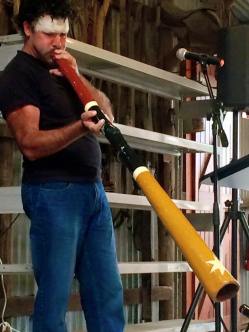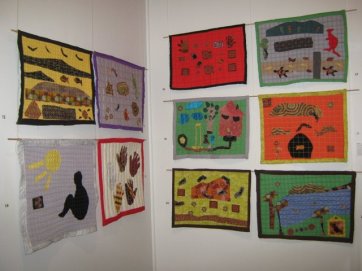In marking the 23rd anniversary of his Redfern speech on Aboriginal dispossession and white Australian responsibility, former prime minister Paul Keating gave another speech earlier this month, as reported by Michael Gordon in the Sydney Morning Herald. “Aboriginal art and culture draw from the land, for Aboriginality and the land are essential to each other and are inseparable,” (Mr Keating said). “In terms of art at its best, Aboriginal art still carries sacred messages through its symbols and materials, yet manages to hold its secrets while speaking to a broader audience. More than that, it has been effective in translating an entire culture and the understanding of an entire continent.”
Rather than re-enter the debate on constitutional recognition and his support for a compact, or treaty, Michael Gordon wrote, Mr Keating explored a bigger proposition – that Australia’s potential will not be realised until the question of identity is settled.
“Whatever our identity today is or has become, it is an identity that cannot be separated from Aboriginal Australia,” he said. “For their 50,000 years here has slaked the land with their resonances, their presence and their spirit.
“Our opportunity is to rejoice in their identity, and without attempting to appropriate or diminish it, fuse it with our own, making the whole richer.”
Across western Sydney there are many opportunities to reflect on what this might mean and how we can be involved.
Talk the Change/Change the Talk: an exhibition of Aboriginal self-determination makes its intention quite clear. It is contributing contemporary Aboriginal perspectives to discussion of Australian constitutional change and recognition after 230 years of white colonisation. Talk the Change is a thought provoking exhibition, which can be seen at Fairfield City Museum and Gallery until February 13. Above is Catherine Croll’s photo of Jeff McMullen delivering the opening speech, on November 28, with Uncle Stephen Williams in the right foreground. For many years a correspondent for the ABC and a host on the National Indigenous Television Network, Jeff McMullen has campaigned locally and internationally for the human rights of indigenous people.
 Talk the Change/Change the Talk is co-curated by Aboriginal descendant, artist and musician, Blak Douglas (aka Adam Hill), who grew up in the Penrith area of western Sydney and Lena Nahlous, the museum and gallery’s curator of social history and exhibitions. Blak Douglas writes in the exhibition catalogue, “We now have entire suburbs where one may be immersed within the vibrancy of cultures from abroad, and there are even festivals of specific flavours. Sadly, though, the reparation of damage to Aboriginal cultures en masse is not occurring at an acceptable rate. Thankfully, utilising art as a voice, we communicate in one of the most powerful mediums . . . .” Blak Douglas, above left, plays the yidaki at the exhibition opening.
Talk the Change/Change the Talk is co-curated by Aboriginal descendant, artist and musician, Blak Douglas (aka Adam Hill), who grew up in the Penrith area of western Sydney and Lena Nahlous, the museum and gallery’s curator of social history and exhibitions. Blak Douglas writes in the exhibition catalogue, “We now have entire suburbs where one may be immersed within the vibrancy of cultures from abroad, and there are even festivals of specific flavours. Sadly, though, the reparation of damage to Aboriginal cultures en masse is not occurring at an acceptable rate. Thankfully, utilising art as a voice, we communicate in one of the most powerful mediums . . . .” Blak Douglas, above left, plays the yidaki at the exhibition opening.
His own contribution to the exhibition is a series of photographs taken at the fifth and tenth anniversaries of the annual Redfern march, which continues to protest the death of teenager TJ Hickey in 2004. The white coroner determined that he was not pursued by police, when he became impaled on a fence. Nonetheless, for Aboriginal people TJ Hickey’s death has become a symbol of ongoing police corruption and violence towards Aboriginal people. More than one in four prisoners in Australia are indigenous Australians, despite comprising only three per cent of the population. Between 1980 and 2011, 449 indigenous Australians died in police custody and no police officer has been convicted for these deaths.
Talk the Change/Change the Talk is a modest and quietly reflective exhibition, which includes radio and oral histories, historic photography, music and visual art. It highlights the struggles of Aboriginal individuals and communities for recognition and justice, the right to speak their own languages and to protect their children from being taken by white authorities. While often a deeply disturbing picture, it is also one of resilience and hope. There is humour and determination in statements like Auntie Mae Robinson’s when people say Captain Cook discovered Australia. “My ancestors didn’t lose it, so how could he have discovered it?” Auntie Mae was the first Aboriginal person to graduate from what became the School of Education at the Milperra College of Advanced Education (1983). She remains a strong advocate for teaching Aboriginal history and culture in schools.
 Well known contemporary artists like Karla Dickens of Wiradjuri descent, display a number of works of protest in the exhibition. She is thankful for the commitment of predecessors, who established the Australian Aborigines’ Progressive Association, and pays tribute to them in a quilt, Having a Voice is Tiresome (2014) while simultaneously expressing frustration that change is coming so slowly.
Well known contemporary artists like Karla Dickens of Wiradjuri descent, display a number of works of protest in the exhibition. She is thankful for the commitment of predecessors, who established the Australian Aborigines’ Progressive Association, and pays tribute to them in a quilt, Having a Voice is Tiresome (2014) while simultaneously expressing frustration that change is coming so slowly.
Speaking of Wiradjuri, it’s worth reading Patti Miller’s The Mind of a Thief, which won the 2013 NSW Premier’s History Award. Patti is a descendant of a German immigrant, who settled on Wiradjuri country, near Wellington in central NSW in the 1850s and whose family has farmed there ever since. She too has felt a connection to land and her explorations of family history and its possible Wiradjuri connections uncover a minefield of history and legislation. She grows to understand how Wiradjuri perspectives are quite different and yet complementary to her own and how respect for elders and their wisdom has diminished, to everyone’s loss. Complexity of Aboriginal relationships is compounded by the Land Council set up by the state government to represent local indigenous people.
A series of art works by Darug descendant Leanne Tobin illustrates the difficulties. The many clans of the Darug were the traditional people of the greater Sydney region and bore the first impact of invasion. For many years, it was assumed that they had all died out. “Even now,” she says, “Darug people are often seen to be ‘too white to be black’, and the continued denial of our very existence by local Aboriginal Land Councils allows continuing selling off and destruction of our tribal lands without consultation with the rightful custodians.”
 Cathie Louise Banton is a granddaughter of Herbert (Bert) Groves, president of the Aborigines’ Progressive Association. Another participant in the exhibition, Cathie recorded an interview with Lena Nahlous, in which she outlined her parent’s struggle with poverty and the brief removal of their five children by white authorities. Later, she endured a violent marriage for 26 years, before finally escaping. Now she finds comfort, support and creative liberation in the Guntawang Aboriginal Women’s Group, which she helped to found in the Fairfield area in August 2013. Guntawang was initiated by Wendy Morgan, who retired from the Commonwealth public service after nearly 30 years and their third founding member was Margaret Roberts. Now 15 women attend fortnightly Guntawang meetings.
Cathie Louise Banton is a granddaughter of Herbert (Bert) Groves, president of the Aborigines’ Progressive Association. Another participant in the exhibition, Cathie recorded an interview with Lena Nahlous, in which she outlined her parent’s struggle with poverty and the brief removal of their five children by white authorities. Later, she endured a violent marriage for 26 years, before finally escaping. Now she finds comfort, support and creative liberation in the Guntawang Aboriginal Women’s Group, which she helped to found in the Fairfield area in August 2013. Guntawang was initiated by Wendy Morgan, who retired from the Commonwealth public service after nearly 30 years and their third founding member was Margaret Roberts. Now 15 women attend fortnightly Guntawang meetings.
“Guntawang’s aims are to help support and strengthen social cohesion and identity for Aboriginal people, encourage creative expression and innovation cross a broad range of arts and crafts activities, and build self esteem for participants to become involved in the wider community.” Members exhibit a series of individual quilts, see above, which tell stories of their dreaming, where they grew up, their families, community totems and belonging to the land. Two of the quilts talk about discrimination and exclusion from the constitution.
 Musician and composer Jacinta Tobin, right, provided some of the lively musical entertainment at the launch. “We can do things differently,” she said. “We don’t have to go down the same angry path as before. Two thirds of our people were lost in the first five years. . . . . . Listen to country – not all the stories you hear are true – listen to country.” Then with a laugh she added, “We won anyway, by marrying into you mob!”
Musician and composer Jacinta Tobin, right, provided some of the lively musical entertainment at the launch. “We can do things differently,” she said. “We don’t have to go down the same angry path as before. Two thirds of our people were lost in the first five years. . . . . . Listen to country – not all the stories you hear are true – listen to country.” Then with a laugh she added, “We won anyway, by marrying into you mob!”
Two more opportunities to immerse yourself in indigenous experience are coming in January. Dharawal Aboriginal Corporation will host the Airds Summer Film and Music Screening series, organised by Campbelltown Arts Centre across four Saturdays. It will screen films like The Sapphires, Bran Nue Dae and the premiere of Black Comedy season two. Then there is the Sydney Festival program Fire Bucket, where you are invited into backyards in Sydney CBD, Redfern and Parramatta. Here you can sit with 93 year old Mt Druitt identity and Bidgambul elder Uncle Wes Marne around the fire bucket, while he yarns with friend and theatre director Alicia Talbot. Every night will be different as they talk of stories, dreams and wisdom. Bookings 1300 856 876 or online.
And then there is the remarkable announcement this week, which has largely gone under the radar – Aboriginal languages to become new HSC subject. “At long last, the Framework for Aboriginal Languages and Torres Strait Islander Languages has been released by the Australian Curriculum Assessment and Reporting Authority as part of the national curriculum,” writes Professor Jakelin Troy in the Sydney Morning Herald. Professor Troy is director of Aboriginal and Torres Strait Islander Research at the University of Sydney and lead author of the Framework for Aboriginal and Torres Strait Islander Languages. “The success of this framework will ultimately hinge upon the level of government backing and financial support our teachers receive. There is still a huge amount of work ahead to support communities and schools to work together to create local language curriculum,” she says.
Another illuminating step towards a different response to our history.







